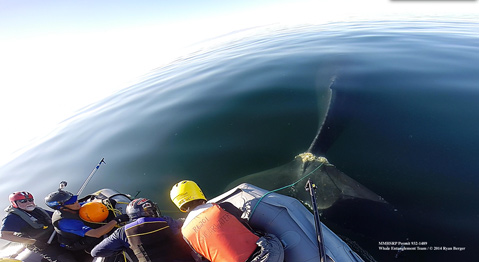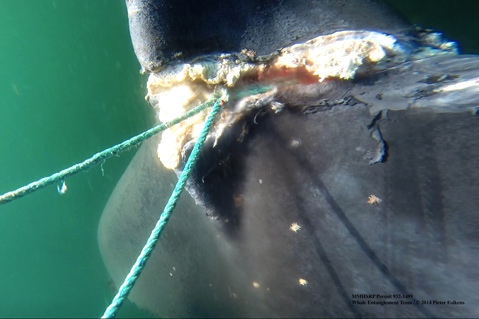Tangled Whale Saved off Santa Barbara Coast
19-Day, 670-Mile Effort Spares Injured Humpback from Certain Death

At noon on April 27, a whale-watching boat in Monterey Bay spotted a young humpback in serious trouble. Its tail was tangled in a crab pot line, and as it dragged the heavy gear through the ocean, the panicky animal struggled to swim and reach the surface to breathe. A call was placed to the Whale Entanglement Team (WET) — an all-volunteer group of biologists, vets, and mariners under the direction of NOAA — which rushed to the scene and delivered the grim news that if the whale wasn’t cut loose, it would surely die.
As the weather turned bad and the sky went dark, the team attached a satellite tag to the 25-foot, 25,000-pound animal and returned to port to regroup. The next morning, the rescue squad was led by Pieter Folkens to the whale’s location, and they were able to remove and retrieve the crab pot and around 250 feet of line. The hope, said Folkens during an interview with The Santa Barbara Independent, was that the remaining rope would slip off on its own.
It didn’t, and over the next two-and-a-half weeks, Folkens and his crew would follow the injured whale along 670 miles of remote and stormy coast in a desperate attempt to save it from the fate that befalls thousands of whales and dolphins every year when they get wrapped in fishing equipment. Though the humpback was freed of the crab pot, Folkens explained, the buoy attached to the other end of the line that had wrapped and cinched around the tail was now preventing the whale from diving properly. It didn’t look good.
On April 29, satellite data showed the whale had moved south of Point Pinos and beyond the range of the responders’ small boats. By May 1, it was swimming near Point Sur — which doesn’t have a place to launch boats — and on May 5 came close enough to shore outside Morro Bay that the team and a California Department of Fish and Wildlife vessel organized a response. However, strong winds and steep seas put the effort on hold.
Two days later, four miles southwest of Point Arguello, the group again tried for a rescue but were again pushed back by weather and bad location. They predicted the whale would soon reach Point Conception, so the team headed to Santa Barbara to organize. Gale force winds whipped through the Santa Barbara Channel for the next week and stifled any hope of reaching the whale.
But at 4 a.m. on May 14, the WET members, accompanied by a boat with the Channel Islands National Marine Sanctuary and Sea World Rescue personnel, pinpointed the whale five miles off Goleta Point and made their move. (The Condor Express had been out looking in the days earlier.) They discovered that the remaining crab pot line was not only wrapped but also knotted around the tail. Folkens said it had cut several inches into the animal’s blubber and tissue, and that while the whale had been alert and energetic during the initial rescue attempts, it had become weak and sluggish by the final push. (A few days into the journey, he also noted, the young whale was joined by three other humpbacks who flailed and thrashed nearby. “We don’t know what was going on, but maybe they were trying to help,” Folkens said.)

By 9 a.m., the group coordinated two of their boats to snag the ends of the line and cut the knot. The rest of the rope soon sloughed away, Folkens said, and the whale immediately perked up and started swimming with greater ease. The team stuck around to monitor it for the next hour, and then left for home confident that their mission was accomplished. “There was an immediate rush of satisfaction,” Folkens remembered, “then a wave of fatigue. But after that, you kind of look at everyone and nod and say, ‘Yeah, we did a good thing today.’”
Folkens explained that for every tangling WET hears about, there are likely nine or more that go unnoticed. The group is especially busy this time of year because the whales’ migration patterns to the area coincide with the crab-fishing season. On May 1, another humpback was spotted entangled in a crab pot near Monterey Bay. However, it was too late in the day to mark it with a telemetry buoy, and it disappeared. Without having the tangle removed, it is unlikely to survive, Folkens said. According to the International Whaling Commission, more than 300,000 whales and dolphins die every year from fishing-gear tangles.



